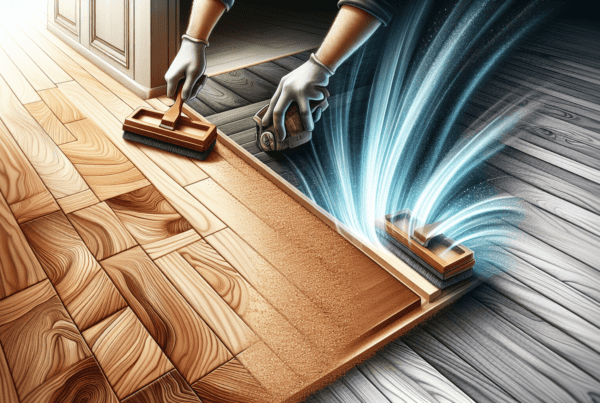Embarking on a journey to breathe new life into our home’s timber floors, we discovered Wellington Timber Floor Revival, a name synonymous with excellence in sanding and finishing. Their expertise in transforming worn-out wooden floors back into their original splendor is unmatched, promising not only a revival of the floors themselves but of the entire ambience of our spaces. With a dedication to quality and an eye for detail, the team at Wellington Timber Floor Revival became our trusted partners in restoring the warmth and beauty of our timber floors, ensuring they shine for years to come.
Wellington Timber Floor Revival: An Overview
The importance of timber floor maintenance
Keeping our timber floors in prime condition is not only crucial for preserving their beauty but also for maintaining the value of our properties. Over time, floors can become scratched, dented, or lose their shine, which detracts from the overall aesthetic of our homes. Regular maintenance, including sanding and finishing, ensures that our floors remain vibrant and durable for years to come.
Sanding and finishing: Key steps in floor restoration
The restoration of timber floors primarily involves two pivotal steps: sanding and finishing. Sanding removes the top layer of the wood, eradicating scratches, dents, and old finish, revealing the raw hardwood beneath. Following sanding, finishing involves applying a protective layer that not only enhances the floor’s appearance but also protects it from wear and tear.
Why choose Wellington experts for your flooring project?
We strongly advocate for engaging Wellington’s timber floor sanding and finishing experts for your flooring projects. Wellington professionals come equipped with the knowledge, tools, and experience necessary to rejuvenate your floors effectively. They understand the local climate and its effects on timber flooring, ensuring your floor restoration or maintenance project is carried out with precision.
Understanding Timber Floors
Types of timber floors
There are various types of timber floors, each with its unique characteristics and appeal. These include solid hardwood, engineered wood, and bamboo, among others. Solid hardwood floors are known for their durability and longevity, while engineered wood floors offer versatility and easier installation. Bamboo floors, on the other hand, offer a sustainable alternative with a distinct natural beauty.
Benefits of having timber flooring
Timber flooring is not only aesthetically pleasing but also offers several practical benefits. It’s durable, easy to clean, and can significantly add to the resale value of our homes. Furthermore, timber floors are known for their timeless appeal, fitting seamlessly with both traditional and contemporary decor.
Common issues faced by timber floors over time
Despite their durability, timber floors can suffer from a range of issues over time, such as scratches from furniture, dents from heavy impact, fading from sunlight exposure, and damage from moisture. Regular maintenance and timely restoration work can mitigate these issues, keeping our floors in excellent condition.
The Process of Floor Sanding
What is floor sanding and why is it necessary?
Floor sanding is the process of removing the top surfaces of a wooden floor by abrasion with sanding materials. It’s necessary for eliminating imperfections, preparing the floor for finishing, and ensuring it looks and feels smooth. This process is crucial for restoring the floor’s original beauty and integrity.
Tools and equipment used in sanding
The sanding process typically involves the use of various tools and equipment, including belt sanders, edge sanders, and orbital sanders. Professionals also utilize dust extraction systems to minimize the amount of airborne dust produced during the process.
Step-by-step guide to the sanding process
The sanding process generally starts with the preparation stage, which involves removing furniture and ensuring the surface is clean. Sanding begins with coarse-grit sandpaper to remove the old finish and significant imperfections, followed by medium-grit and fine-grit sandpapers to smooth the surface. Craftsmen methodically work their way through these stages to ensure an even and smooth finish.
How professionals ensure dust-free sanding
Wellington’s timber floor revival experts employ advanced dust extraction systems that capture dust at the source, significantly reducing the amount of airborne dust. This ensures a cleaner working environment and minimizes cleanup, making the process more efficient and less intrusive.
Floor Finishing Techniques
Types of finishes available for timber floors
A range of finishes is available for timber floors, including polyurethane, oil-based finishes, and water-based finishes. Each type of finish offers distinct advantages in terms of appearance, protection, and maintenance requirements.
Choosing the right finish for your floor
Choosing the right finish for your timber floor depends on several factors, including the type of wood, the level of traffic your floor will endure, and your aesthetic preferences. Consulting with a Wellington flooring expert can help you make an informed decision that suits your specific needs.
The application process of various finishes
The application of floor finishes typically involves several coats, with sanding in-between coats to ensure adhesion and smoothness. The process varies slightly depending on the type of finish, but careful application and attention to detail are crucial for achieving a quality finish.
How to maintain the newly finished floor
To maintain the newly finished floor, regular cleaning with a soft broom or microfiber mop is recommended. Avoid using harsh chemicals or excessive water, as these can damage the finish. Placing mats at entrances and protecting the floor from furniture scratches are also advisable to preserve its beauty.
DIY Vs. Professional Services
Pros and cons of DIY floor sanding and finishing
DIY floor sanding and finishing can be cost-effective and rewarding for those with the necessary skills. However, it’s a labor-intensive process that requires a high level of precision. Without proper equipment and experience, there’s a risk of damaging the floor, leading to further expenses.
When to call in the professionals
We recommend calling in professionals for sanding and finishing projects when the task requires specialized knowledge, equipment, or when the quality of finish is paramount. Professionals can ensure a high-quality result that lasts longer and looks better.
What to look for in a professional service provider
When selecting a professional service provider, consider their reputation, experience, and the quality of their previous work. Reliable service providers are transparent about their processes, offer clear quotes, and can provide references or testimonials from satisfied customers.
Choosing the Right Service Provider
Qualities of reputable floor sanding and finishing experts
Reputable floor sanding and finishing experts are known for their attention to detail, quality of work, and commitment to customer satisfaction. They use high-quality materials and state-of-the-art equipment to deliver exceptional results.
How to vet potential service providers
To vet potential service providers, ask for detailed quotes, inquire about their process, and request before-and-after photos of previous projects. Checking online reviews and soliciting recommendations from friends and family can also offer valuable insights.
Understanding quotes and services offered
Understanding quotes and services offered is crucial for making an informed decision. Ensure the quote includes all aspects of the project, from preparation to finishing touches, and clarifies any additional costs that may arise.
Cost Considerations
Estimating the cost of sanding and finishing
The cost of sanding and finishing a timber floor depends on several factors, including the floor’s condition, area size, and the type of finish selected. Wellington experts can provide a detailed quote based on an assessment of your specific needs.
Factors that influence the overall price
Factors influencing the overall price include the complexity of the job, the need for repairs or replacement boards, and the choice of finishing products. Geographic location and the current state of the floor also play a role in determining the final cost.
Tips for budgeting your floor revival project
To budget effectively for your floor revival project, start by obtaining several quotes from reputable providers to gauge the market rate. Consider prioritizing quality over the lowest price, as a well-done job will last longer and offer better value in the long run.
Case Studies
Before and after transformations in Wellington homes
Wellington homes have seen remarkable transformations through timber floor revival projects. Before-and-after photos showcase the dramatic difference that professional sanding and finishing can make, turning worn-out floors into stunning showcases.
Testimonials from satisfied customers
Testimonials from satisfied customers often highlight the professionalism, work quality, and the difference the project made to their homes. Many express their satisfaction with the attention to detail and the overall value added to their property.
Lessons learned from challenging projects
Challenging projects often teach valuable lessons, such as the importance of proper preparation, choosing the right finish for specific types of wood, and the benefits of leveraging professional expertise for complex tasks.
Maintenance Tips Post-Revival
Daily maintenance routines for timber floors
Daily maintenance routines for timber floors include sweeping or vacuuming to remove dirt and grit and using recommended cleaning products for routine mopping. Immediate cleaning of spills can prevent water damage and staining.
Preventive measures to avoid damages
Preventive measures to protect timber floors include using felt pads under furniture legs, avoiding high heels and sharp objects on the floor, and maintaining a stable indoor humidity level to prevent warping.
Dealing with scratches and stains on finished floors
For minor scratches, touch-up kits or wax sticks can be used. Deeper scratches may require professional attention. Stains can often be removed with specialized cleaning products, but persistent stains might necessitate localized sanding and refinishing.
FAQs About Timber Floor Revival
How often should timber floors be sanded and finished?
Timber floors should be sanded and finished every 10 to 15 years, depending on traffic and wear. Regular maintenance can extend the intervals between full revivals.
Can all types of timber floors be revived?
Most types of timber floors can be revived, including solid wood, engineered wood, and parquet floors. The specific technique may vary depending on the floor type.
How long does the sanding and finishing process take?
The sanding and finishing process typically takes several days, depending on the floor’s size and condition. Additional time for drying and curing of the finish should also be considered.
How to prepare your home for the revival process?
Preparing your home for the revival process involves removing furniture and rugs, securing loose items, and ensuring a clear workspace for the professionals. Adequate ventilation is also crucial for managing dust and fumes.







